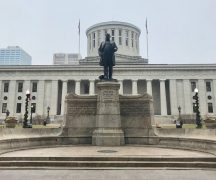A legislative attempt to cripple the Ohio Department of Health’s legal authority to respond to pandemics died a quiet death Tuesday evening after the Senate President opted against attempting to override a gubernatorial veto.
This puts a lid — for 2020, at least — on a months-long effort from Republicans to wrest “ultimate authority” in matters of quarantine and isolation from the ODH director, as it exists in state law.
Senate Bill 311 would allow lawmakers to vote down public health orders, such as the statewide mask mandate.
It would also prevent ODH from issuing a statewide or regional quarantine or isolation order against people who have not been exposed to or diagnosed with an infectious disease. Legal experts say this would preclude the health department from issuing stay-at-home orders, as it did this Spring.
The legislation formed a wedge between Republican lawmakers and GOP Gov. Mike DeWine, who vetoed the bill earlier this month after calling the proposal a “disaster.” Lawmakers have pushed a string of different attempts to weaken ODH’s public health power since April.
Lawmakers passed the bill despite opposition from the Ohio Hospital Association, the Ohio State Medical Association, and public health officials. They said the bill would weaken the state’s ability to respond to COVID-19, which has killed 8,252 Ohioans since March.
Senate President Larry Obhof, R-Medina, spoke to reporters late Tuesday night after the final full voting session of the 133rd General Assembly. He said passing separate legislationdesigned to force ODH to treat large and small businesses more equitably in the event of another shutdown was a viable alternative to a veto override. The House would need to approve this by year’s end.
The Senate passed SB 311 with 20 votes, leaving none to spare on the 3/5 majority needed to override. Four Republican senators — Matt Dolan, Peggy Lehner, Stephanie Kunze, and Kirk Schuring — joined with Democrats to oppose the bill.
However, the political calculations change. A single vote flip wouldn’t have made much difference on passage but could torpedo the veto override outright, which must begin in the Senate per constitutional rules.
It would also have needed 60 votes in the House, a more complex endeavor.
The House passed SB 311 with 58 GOP votes, two shy of the override threshold. Three likely yes votes were absent at the time.
However, activists have since worried about two Republicans they called “weak links” in the override chain — Reps. Gayle Manning and Dave Greenspan, both of whom voted against a more robust version of similar legislation this Spring.
During interviews earlier this month, they both declined comment on whether they’d vote to override the veto.
A rash of COVID-19 cases among House lawmakers also scuttles the whip count. At least seven House lawmakers have contracted COVID-19 in December. The Cincinnati Enquirer reported at least 13 House legislators were absent from voting Tuesday, including six Republicans.
Obhof described the legislation passed Tuesday as a pragmatic compromise, although he still supports SB 311. He said the thinned-out House Republican caucus was a factor in his decision, but not the driving force.
“The House hasn’t had 60 Republican members in in weeks,” he said. “That’s not why we didn’t pass it, but I think it is an important background fact when you see some members clamoring for that and demanding that.”
The bill was the subject of tremendous pressure. House lawmakers accused Obhof of stalling on the bill. Activists, some of whom were armed, did as well when they showed up outside his home Sunday calling on him to pass the legislation.
Any member can introduce similar legislation when the next General Assembly convenes next year, although the entire process would have to restart.
***
Also from Ohio Capital Journal:
COVID-19 cases in schools still grow leading up to holiday break
A Butler County school tops the reported student cases in schools as the state’s districts head into their holiday breaks.
Some schools have seen significant case increases in the last month, even with breaks for Thanksgiving and various hybrid online and in-person learning models.
Lakota Local Schools reported 357 total cases in the most recent statewide school COVID-19 report, moving past Franklin County’s Dublin City Schools, who reported a total of 305 cases throughout the district.
Lakota conducted some in-person classes since the beginning of the school year, but on Dec. 14, the district’s board of education voted to change that starting in January.
“We know that holding in-person learning for those who have chosen it is best for our students,” said Superintendent Matthew Miller in the announcement of the schedule changes. “However, the increase in positive cases we are seeing throughout our community following holidays has a direct impact on our students and staff attendance.” READ MORE
Covid crowds some out of Ohio hospitals, federal release shows
Hospital beds in Ohio and elsewhere are filling with coronavirus patients, prompting the federal government to ease rules and allow more people to be treated at home. But for some reason, top Ohio health officials don’t seem to want to say that.
Among other experts, Ashish K. Jha has reported that nationally the portion of covid sufferers being hospitalized began dropping at the beginning of November and the trend accelerated from there. Jha, the dean of the Brown University School of Public Health, called that “terrible news” because it meant that as hospitals have filled they’ve begun admitting fewer people.
But last week when he was asked if that’s happening in Ohio, Bruce Vanderhoff, chief medical officer with the Ohio Department of Health, said it wasn’t. He said that even before the pandemic, Ohio hospitals were looking for ways to care for patients without admitting them.
“So I don’t think it’s true… that (hospitals are) consciously not bringing someone in that they previously brought in unless they now feel they’ve got a better way of treating them that keeps them out of the hospital,” Vanderhoff said. READ MORE





